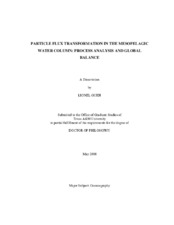| dc.contributor.advisor | Gorsky, Gabriel | |
| dc.contributor.advisor | Jackson, Geroge | |
| dc.creator | Guidi, Lionel | |
| dc.date.accessioned | 2008-10-10T20:57:06Z | |
| dc.date.available | 2008-10-10T20:57:06Z | |
| dc.date.created | 2008-05 | |
| dc.date.issued | 2008-10-10 | |
| dc.identifier.uri | https://hdl.handle.net/1969.1/85946 | |
| dc.description.abstract | Marine aggregates are an important means of carbon transfers downwards to the deep ocean as well as an important nutritional source for benthic organism communities that are the ultimate recipients of the flux. During these last 10 years, data on size distribution of particulate matter have been collected in different oceanic provinces using an Underwater Video Profiler. The cruise data include simultaneous analyses of particle size distributions as well as additional physical and biological measurements of water properties through the water column. First, size distributions of large aggregates have been compared to simultaneous measurements of particle flux observed in sediment traps. We related sediment trap compositional data to particle size (d) distributions to estimate their vertical fluxes (F) using simple power relationships (F=Ad^b). The spatial resolution of sedimentation processes allowed by the use of in situ particle sizing instruments lead to a more detailed study of the role of physical processes in vertical flux. Second, evolution of the aggregate size distributions with depth was related to overlying primary production and phytoplankton size-distributions on a global scale. A new clustering technique was developed to partition the profiles of aggregate size distributions. Six clusters were isolated. Profiles with a high proportion of large aggregates were found in high-productivity waters while profiles with a high proportion of small aggregates were located in low-productivity waters. The aggregate size and mass flux in the mesopelagic layer were correlated to the nature of primary producers (micro-, nano-, picophytoplankton fractions) and to the amount of integrated chlorophyll a in the euphotic layer using a multiple regression technique on principal components. Finally, a mesoscale area in the North Atlantic Ocean was studied to emphasize the importance of the physical structure of the water column on the horizontal and vertical distribution of particulate matter. The seasonal change in the abundance of aggregates in the upper 1000 m was consistent with changes in the composition and intensity of the particulate flux recorded in sediment traps. In an area dominated by eddies, surface accumulation of aggregates and export down to 1000 m occured at mesoscale distances (<100 km). | en |
| dc.format.medium | electronic | en |
| dc.language.iso | en_US | |
| dc.publisher | Texas A&M University | |
| dc.subject | marine snow | en |
| dc.subject | carbon flux | en |
| dc.subject | mesopelagic layer | en |
| dc.subject | aggregation | en |
| dc.subject | biogeochemistry | en |
| dc.subject | size distribution | en |
| dc.title | Particle flux transformation in the mesopelagic water column: process analysis and global balance | en |
| dc.type | Book | en |
| dc.type | Thesis | en |
| thesis.degree.department | Oceanography | en |
| thesis.degree.discipline | Oceanography | en |
| thesis.degree.grantor | Texas A&M University | en |
| thesis.degree.name | Doctor of Philosophy | en |
| thesis.degree.level | Doctoral | en |
| dc.contributor.committeeMember | Gardner, Wilford | |
| dc.contributor.committeeMember | Sempéré, Richard | |
| dc.contributor.committeeMember | Stemmann, Lars | |
| dc.contributor.committeeMember | Toby, Ellen | |
| dc.type.genre | Electronic Dissertation | en |
| dc.type.material | text | en |
| dc.format.digitalOrigin | born digital | en |


